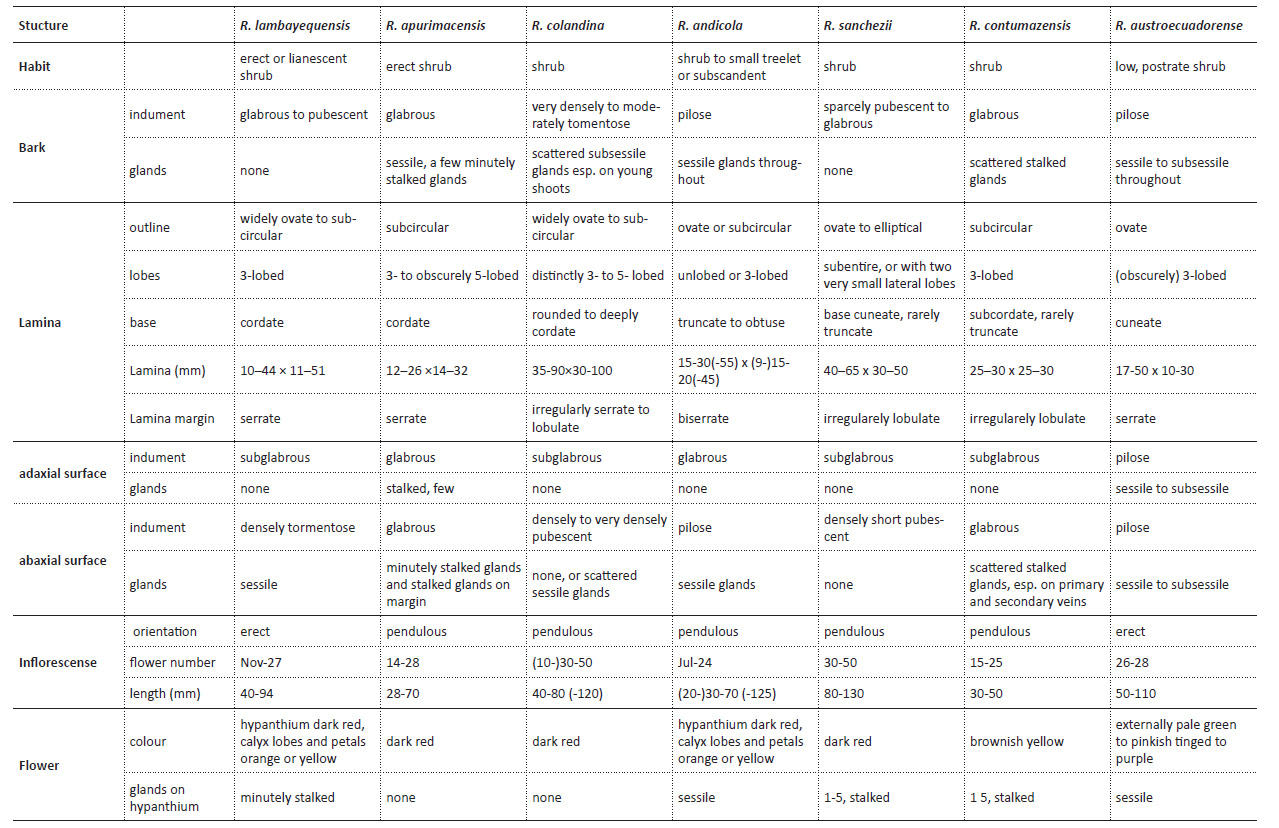Introduction
The genus Ribes as the only genus in the family Grossulariaceae includes several economically important species in the northern hemisphere, especially western Eurasia. The genus is highly diverse in the northern hemisphere, especially Eastern Asia, but also North America, with a considerable number of species in South America (Janczewski 1907). South American species have been rarely investigated and only in recent decades have they been studied in more detail, leading to the description of a range of new species from Colombia and Ecuador (Freire-Fierro 1998, 2002, 2004; Weigend & Binder 2001a), but also Bolivia (Weigend & Binder 2001b). Our knowledge on Peruvian species had last been summarized by Macbride (1941), and in recent years critical field and herbarium work lead to the recognition of a range of new species (Weigend & Rodriguez 2005; Weigend et al. 2005, 2010). The border region of Ecuador and Peru, the so-called Amotape-Huancabamba Zone, has been shown to be a centre of diversity for the genus (Weigend 2002, 2004) supported by a recent study that identified this region as a global centre of microendemism in the Andes (Mutke et al. 2014). In Peru, representatives of the genus Ribes are particularly common at the upper margins of cloud forest and in forest islands in the paramo and puna vegetations, typically well above 3000 m of altitude. The Ribes andicola-group (Weigend et al. 2005) - as previously known - range from Venezuela and Colombia to northern Peru, and it finds its southern range limit in the Department of La Libertad with Ribes colandina Weigend. Ongoing fieldwork and examination of specimens in Peruvian herbaria have now yielded another two new species of the genus from Peru, both of which are allied to the Ribes andicola-group (Weigend et al. 2005). Field studies in the Department of Lambayeque in 2014 yielded material of a new species that is clearly allied to this group. Additionally, studies of specimens kept in the herbarium of the Universidad Nacional Mayor de San Marcos in Lima (USM) has also yielded a new species clearly belonging to this group from Apurimac. The two new species are here described and their affinities to the Ribes andicola-complex discussed.
Material and methods
A total of 10 Ribes specimens from the collections of BONN and USM herbaria were analyzed. Bud scales, leaves, inflorescences, flowers, bracts, bracteoles and fruits of the specimens were measured. The leaf trichome cover was studied under the stereomicroscope.
Results
The two new species described here are morphologically similar to the species of Ribes andicola group, sharing the medium-sized, three- to obscurely five-lobed leaves and many-flowered inflorescences with short, cyathiform to shortly campanulate flowers typical of this group. The specimens from Lambayeque and Apurímac clearly differs from the previously described species in a number of characters, which are summarized in Table 1. The specimens here assigned to the new species R. lambayequensis differ from its geographical neighbor R. colandina by erect inflorescences with up to 27 (30) flowers versus pendulous inflorescences with up to 50 flowers and yellow to pale orange calyx lobes on a red hypanthium versus uniformly dark red flowers in R. colandina. Erect inflorescences are otherwise only found in R. austroecuadorense from the northernmost part of Cajamarca and Ecuador, but that species differs clearly by cuneate leaf bases (vs. cordate in R. lambayequensis) and a glandular indument (eglandular in R. lambayequensis). Similarly, the specimens here assigned to the new species R. apurimacensis differ clearly in indument: This species lacks simple trichomes, but the leaves are covered with (often minutely) stalked glands on both leaf surfaces. The only species similar in that respect is the microendemic species R. contumazensis from Cajamarca, which differs in having glands only on the veins on the abaxial leaf surface. The other species of this group - R. colandina, R. andicola and R. lambayequensis - have adaxially eglandular leaves and sessile glands on their abaxial surfaces and are pubescent from simple trichomes at least abaxially. Also, with the lamina only 12-26 × 14-32 mm the leaves of R. apurimacensis are smaller than those of any other species of this complex.
Taxonomic treatment
Ribes lambayequensis Weigend, sp. nov.
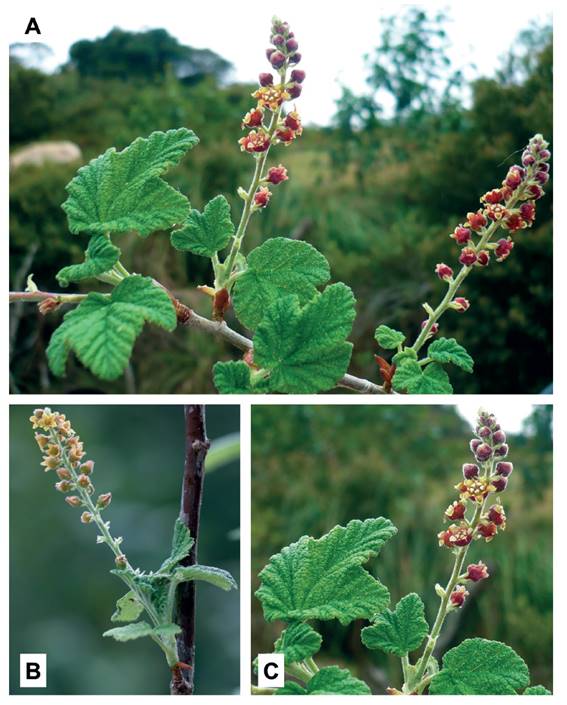
Figure 1 Ribes lambayequensis inflorescence, flowers with red to reddish-green hypanthia and calyx lobes and petals yellow to orange. A, C. male flowering branches, note the conspicuous anthers and the poorly developed inferior ovary (Weigend et al. 9661, USM, BONN). B. female inflorescences, note the rudimentary anthers and well-developed inferior ovary (Weigend et al. 9662, USM, BONN).
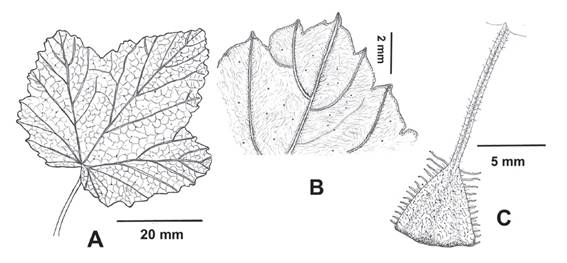
Figure 2 Leaf morphology of Ribes lambayequensis. A. Distinctively three-lobed, subcircular lamina. B. Densely tomentose abaxial surface with scattered sessile glands. C. Basally widened petiole, stipular region with numerous stalked glands. (A-C: Weigend 9661, BONN).
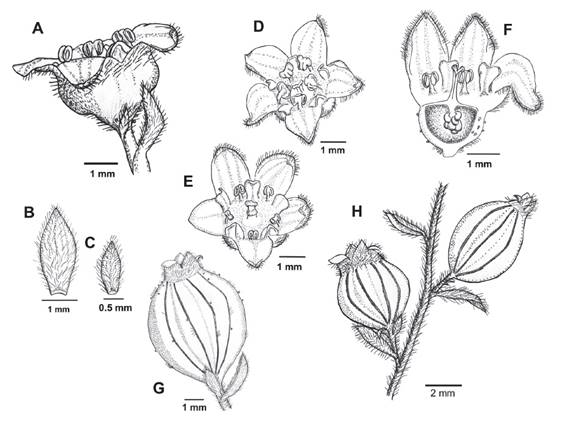
Figure 3 Ribes lambayequensis flowers and fruit. A, D. Male flower. B-C. Bract and bracteole (Weigend 9661, BONN). D, F. Female flower (Weigend 9662, BONN). G-H. Immature fruit with, minutely stalked stalked glands (Weigend 9662, BONN).
Type: PERU, Lambayeque, Prov. Ferreñafe, Road Incahuasi to Sinchihual and Tungula, 6°12'7.7"S, 79°17' 57.7"W, 2897 m, 24 November 2014, Weigend et al. 9661( holotype USM!, isotype BONN!).
Erect or lianescent shrub ca. 3 m high; bark matt brown or whitish, eglandular, glabrous to pubescent with unicellular white hairs (ca. 0.1 - 0.3 mm long) especially on young shoots. Bud scales ovate, apex acute, 1.5 -3(- 6) mm long and 2 - 4 mm wide, finely pubescent with many simple individual small white hairs with sessile glands located dorsally. Leaves deciduous; petiole 8 - 29 mm long; slightly dilated in the stipular region with many glandular trichomes, glandular with long stalked with trichomes glands (1 - 3 mm) restricted to the margin, densely tomentose with simple curly white hairs (ca. 0.5 - 0.7 mm long). Lamina subcircular, 10 - 44 mm long, 11 - 51 mm wide; distinctly three lobed with central lobe slightly longer (1.5 ×) than lateral lobes, lateral and central lobes triangular-ovate, free portion of central lobe 4 - 12 -19(- 25) mm long, 5 - 14 -19(- 23) mm wide, lateral lobes up to 9 × 13 mm, incisions between lobes ½ of leaf length; margin serrate; leaf base cordate; adaxial surface subglabrous with scattered simple individual hairs ca. 0.1 mm long, eglandular; abaxial surface densely tomentose with simple individual curly white hairs ca. 0.4 - 1 mm long, with few sessile glands. Inflorescence terminal on brachyblasts, racemes stiffly erect, 40 - 94 mm long in flower with 11 - 27 flowers each (male and female); peduncle 11 - 25 mm long, tomentose with many white simple individual curly hairs, glandular with scattered stalked and sessile glands; pedicels 1-1.5 mm long, ca. 1 - 2 mm apart in open flowers, covered with many simple individual curly white hairs; bracts lance-ovate and apex acute, ca. 1.5 - 2.5 mm long, 1 mm wide, with many simple individual white hairs, eglandular; bracteoles lance-ovate and apex acute, 1 mm long, tomentose with many simple individual white hairs. Flowers bowl-shaped, 3 - 4.5 mm long and 2 - 4 mm wide, corolla yellowish orange to dark red; hypanthium 1 - 2 mm long, covered with very few simple individual white hairs and scattered minute stalked glands especially toward the ovarian portion; calyx lobes widely ovate and apex acute, reflexed, 1.5 - 2.5 mm long, 1 - 1.5 mm wide, tomentose covered with many simple small white hairs restricted only to the abaxial surface; petals narrowly oblong and apex truncate to rounded, ca. 1 mm long; stamens 5, filaments and anthers 0.5 mm long, longitudinal dehiscence, style apically bifid; ovary inferior, fused with hypanthium. Fruit a berry, spherical, ca. 4.5 - 6 mm in diameter, subglabrous with very few simple individual hairs, and with scattered minute stalked glands; perianth remnants ca. 1 mm long.
Distribution and Habitat: The new species is currently known only from a single locality in the department of Lambayeque in the Province of Ferreñafe, where also is present R. colandina. The type collection comes from the remnants of cloud forest and subparamo vegetation at an elevation of ca. 2900 m.
Phenology: The flowering material was collected in November and the species likely flowers just before the beginning of the rainy season like most Andean species of the genus.
Etymology: The specific epithet is derived from Lambayeque, the name of the Peruvian department where the type collection came from.
Relationships: Ribes lambayequensis is clearly a member of the Ribes andicola group (Table 1), but can be immediately distinguished by its erect inflorescences with 11 - 27 flowers with reflexed calyx lobes contrasting with the pendulous inflorescences with porrect calyx lobes of R. andicola and R. colandina. Also, this species is distinguished from the other members of its group by its subcircular lamina (10 - 44 mm long, 11 - 51 mm wide) and consistently three-lobed leaves (Table 1). In addition, the new species here described differs in details of the indumentum, gland cover, and leaf morphology (Table 1). R. lambayequensis has eglandular bark in contrast to R. colandina and R. andicola with glandular bark. Ribes lambayequensis presents clearly three-lobed leaves, with cordate bases. Conversely, R. colandina has three- to five-lobed leaves, with a rounded to deeply cordate leaf base. The leaves of R. andicola are unlobed or three-lobed leaves with a truncate to obtuse base (Table 1). Also, R. lambayequensis has minutely stalked glands in the hypanthium versus R. andicola with sessile glands.
Specimens examined: PERU: Lambayeque: Prov. Ferreñafe, Road Incahuasi to Sinchihual and Tungula, remnants of cloud forest and subparamo vegetation in river valley after Sinchihual, 2897 m, 6°12'7.7"S, 79°17' 57.7"W, 24 November 2014, M. Weigend, et al. 9662 (BONN!, USM, HUT); Road Incahuasi to Sinchihual and Tungula, 2897m, 6°12'7.7"S, 79° 17'57.7"W, 24 November 2014, M. Weigend et al. 9661 (BONN!, USM, HUT).
Ribes apurimacensis Weigend, sp. nov.
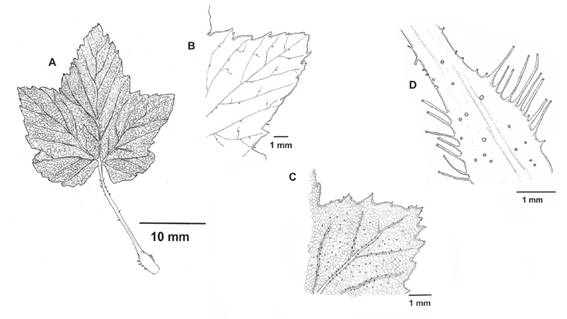
Figure 4 Ribes apurimacensis leaf. A. Subcircular, obscurely five-lobed leaf. B. Adaxial surface of individual leaf lobe with scattered stalked glands. C. Abaxial surface of individual leaf lobe with (minutely) stalked glands. D. Basally widened petiole, stipular region with three type of glands (minutely stalked, long stalked and sessile glands) (all Vargas & Mora 194, USM).
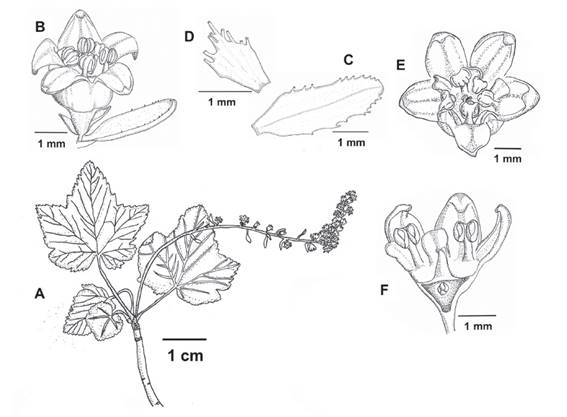
Figure 5 Ribes apurimacensis. A. Flowering brachyblast. B, E. male flower with conspicuously developed anthers. C-D. ciliate bract and bracteole. F. longitudinal section of the flower showing the oblong petals with truncate apex, and the inferior ovary fused with the hypanthium (all from Vargas & Mora 194, USM, BONN!).
Type: PERU, Apurímac, Prov. Andahuaylas, District of Pampachiri, Qenta, 2500 m, January 2004, L. Vargas, G. Mora 194 (holotype USM!)
Shrub; bark matt brown to bright gray, glandular young with sessile and few minutely stalked glands, glabrous. Bud scales ovate, apex obtuse, 4-10 mm long and 3-5 mm wide, glabrous and slightly glandular with scattered and very few minutely stalked glands located on margin. Leaves deciduous; petiole 9 -20 mm long; dilated in the stipular region; glabrous, glandular with many long-stalked glands (0.6 - 1.5 mm) restricted to the margin, scattered and few minutely stalked, and sessile glands (ca. 0.1 mm). Lamina subcircular, 12 - 26 mm long, 14 - 32 mm wide; three -to obscurely five- lobed, in case of five-lobed the lateral lobes towards the base poorly developed, central lobe slightly longer (1.2 - 1.3 × ) than lateral lobes, lateral and central lobes triangular, free portion of central lobe 6 - 12 mm long, 6 - 12 mm wide, lateral lobes up to 9 × 8 mm, incisions between lobes ½ of leaf length; margin serrate; leaf base cordate; adaxial surface glabrous, glandular with few stalked; abaxial surface glabrous, glandular with stalked glands restricted to the margins. Inflorescence terminal on brachyblasts, racemes pendulous, 28 - 70 mm long in flower with 14 - 28 flowers; peduncle 10 - 12 mm long, glabrous, glandular with scattered subsessile and minutely stalked glands; pedicels up to 1 mm long, ca. 1 mm apart in open flowers, glabrous; bracts oblong and apex obtuse to rounded, ciliate, ca. 3 - 4 mm long, 1 - 1.5 mm wide, glabrous, glandular with minutely stalked restricted to the margin; bracteoles ovate and apex acute, ciliate, 1.5 mm long, glabrous, glandular with minutely stalked glands restricted to the margin. Flowers bowl-shaped, 3 - 4.5 mm long and 3.5 - 4.5 mm wide, corolla dark red; hypanthium 1 - 1.5 mm long, glabrous and eglandular; calyx lobes oblong and apex acute, reflexed, ca. 1.5 - 2 mm long, 1 - 1.5 mm wide, glabrous; petals oblong and apex truncate, ca. up to 1 mm long; stamens 5, filaments 0.5 - 0.6 mm long and anthers 0.4 - 0.5 mm long, longitudinal dehiscence, style deeply bifid; ovary inferior, fused with hypanthium. Fruit unknown.
Distribution: This new species is currently only known from a single locality in Peru in the Department of Apurímac, in the Province Andahuaylas at an elevation of 2500 m.
Phenology: The type specimen was collected flowering in April.
Etymology: The specific epithet is derived from Apurímac, the name of the Peruvian department where the type collection came from.
Relationships: This new species is evidently morphologically allied to R. colandina and R. lambayequensis, the other new species described here (Table 1). Ribes apurimacensis can be distinguished from the other species of this group by its lack of simple trichomes (Table 1). The leaves of R. apurimacensis possess sessile and two sizes of stalked glands on their adaxial and abaxial surfaces, which distinguishes it from the other species of the group apart from Ribes contumazensis (for differences see Table 1).
Examined specimen: PERU: Apurímac: Prov. Andahuaylas, District of Pampachiri, Qenta, 2500 m, Juanuary 2004, L. Vargas & G. Mora 194 (USM!).












 uBio
uBio 

